Research Article
Biofield Energy Treatment and its Impact on the Isotopic Abundance of Cholecalciferol (Vitamin D3)
7759
Views & Citations6759
Likes & Shares
Cholecalciferol is a fat-soluble vitamin (Vitamin D3). It is used for the prevention and treatment of rickets, osteoporosis, arthritis, Parkinson’s and Alzheimer’s diseases, etc. In this study, the LC-MS and GC-MS analytical methods were used to characterize and evaluate the isotopic abundance ratios of PM+1/PM and PM+2/PM of the Trivedi Effect®-Consciousness Energy Healing Treated cholecalciferol compared to the control sample. The test sample cholecalciferol was divided into control and treated parts. Only, the treated cholecalciferol was received the Trivedi Effect®-Consciousness Energy Healing Treatment remotely by a renowned Biofield Energy Healer, Mahendra Kumar Trivedi. The LC-MS spectra of both the samples at retention time (Rt) ~22 min exhibited the mass of the molecular ion peak at m/z 385.25 (called for C27H45O+, 385.35). The LC-MS based isotopic abundance ratio of PM+1/PM in the treated cholecalciferol was increased by 2.93% compared with the control sample. Similarly, the GC-MS based isotopic abundance ratio of PM+1/PM and PM+2/PM in the treated cholecalciferol was increased by 1.53% and 3.22%, respectively compared with the control sample. Hence, 13C, 2H, 17O and 18O contributions from C27H44O+ to m/z 386 and 387 in the treated cholecalciferol were significantly increased compared with the control sample. The isotopic abundance ratios of PM+1/PM (2H/1H or 13C/12C or 17O/16O) and PM+2/PM (18O/16O) in the treated cholecalciferol were significantly increased compared to the control sample. The increased isotopic composition of the Trivedi Effect®-Consciousness Energy Healing Treated cholecalciferol might have altered the neutron to proton ratio in the nucleus via the possible mediation of neutrino. The increased isotopic abundance ratio of the treated cholecalciferol may increase the intra-atomic bond strength, stability, and shelf-life. The new form of cholecalciferol would be more efficacious pharmaceutical/nutraceutical formulations for the prevention and treatment of various diseases such as vitamin D deficiency, rickets, osteoporosis, arthritis, multiple sclerosis, cancer, mental disorders, diabetes mellitus, cardiovascular diseases, hypertension, infections, influenza, cognitive impairment in older adults, Parkinson’s and Alzheimer’s diseases, dementia, autoimmune disease, glucose intolerance, multiple sclerosis, etc.
Keywords: Consciousness Energy Healing Treatment, The Trivedi Effect®, Cholecalciferol, Isotopic abundance
INTRODUCTION
Cholecalciferol is a fat-soluble vitamin (Vitamin D3). Humans synthesize vitamin D3 in the skin on exposure to UV light is biologically inert [2]. It gets activated by hydroxylation in the liver and kidney to 1,25-dihydroxycholecalciferol (calcitriol). Vitamin D binding proteins (DBPs) are found in most of the body parts, i.e., heart, lungs, kidney, liver, pancreas, intestines, muscles, gonads, brain, nervous system, etc. Vitamin D regulates the functions of the muscles, lungs, liver, kidneys, heart, brain, pancreas, intestines, and immune system. Vitamin D receptor response elements with hundreds of genes directly or indirectly influence cell-to-cell communication, normal cell growth, cell cycling, and proliferation, cell differentiation, neurotransmission, hormonal balance, increase calcium and phosphorus absorption, skin health, immune, and cardiovascular functions [3-5].
people are equally high risk for. The cause of vitamin D deficiency is inadequate exposure to sunlight, high body mass index (>30 kg/m2), patient taking anticonvulsants and anti-AIDS/HIV medications, fat malabsorption syndromes and bariatric patients, chronic liver disease, hypophosphatemia, and hypocalcemia [2,4]. Vitamin D deficiency may cause abnormalities in calcium, phosphorus, and bone metabolism, rickets, osteoporosis, arthritis, cancer, diabetes mellitus, mental disorders, multiple sclerosis, hypertension, cardiovascular diseases, infections, influenza, cognitive impairment, Parkinson’s disease, Alzheimer’s diseases, autoimmune disease, dementia, glucose intolerance, multiple sclerosis, etc. [1,2,5-8]. The daily requirements of vitamin D for all individuals between the ages of 1 and 70 years old is 15 µg/d (600 IU per day) [1-4]. High dose of supplementation may cause toxicity like hypercalcemia, polyuria, polydipsia, weakness, mental retardation, and insomnia [8]. The stability of vitamin D is more concerned as it is more sensitive to heat and light [9,10].
Bioavailability of vitamin D3 directly affected by various factors such as dietary fiber, genetic factors, age, skin color, and status of vitamin D3 [11]. The Trivedi Effect®-Consciousness Energy Healing Treatment is a form of Energy Therapy that improved the bioavailability profile of several nutraceutical and pharmaceutical compounds [12-14]. The Trivedi Effect® is a scientifically proven Energy Therapy in which a Biofield Energy Healer can harness this inherently intelligent energy from the Universe and transfer it anywhere on the planet through the possible mediation of neutrinos [15]. The Biofield based Energy Healing Therapies nowadays has been used against various disease conditions [17,18]. The Energy Therapy has been recognized worldwide as a Complementary and Alternative Medicine (CAM) health care approach by the National Center of Complementary and Integrative Health (NCCIH) with other therapies, medicines and practices such as Ayurveda, homeopathy, yoga, aromatherapy, Qi Gong, Tai Chi, traditional Chinese herb and medicines, chiropractic/osteopathic manipulation, hypnotherapy, acupressure, acupuncture, movement therapy, naturopathy, Reiki, etc. [19]. The CAM therapies have been well accepted by most of the U.S.A. people [20]. The Trivedi Effect®-Consciousness Energy Healing Treatment also potentially transforms the characteristic properties of polymers, metals, ceramics, pharmaceuticals, nutraceuticals, organic compounds, microbes, cancer cells [21-30], and improve the yield of crops [31,32].
The study of natural stable isotope analysis has a lot of applications in several fields of sciences to understand the isotope effects [33-35]. Liquid chromatography-mass spectrometry (LC-MS) and Gas chromatography-mass spectrometry (GC-MS) is widely used for the analysis of isotope ratio with sufficient precision [34]. In this study, the LC-MS and GC-MS analytical methods were used to characterize the structural properties and evaluated the isotopic abundance ratios of PM+1/PM (2H/1H or 13C/12C or 17O/16O) and PM+2/PM (18O/16O) of the Trivedi Effect®-Consciousness Energy Healing Treated cholecalciferol compared to the control sample.
MATERIALS & METHODS
Chemicals and reagents
The test sample cholecalciferol (≥ 98%, HPLC) was procured from Sigma-Aldrich, India. Similarly, the other chemicals, i.e., acetonitrile and methanol were purchased from Merck, India.
Consciousness energy healing treatment strategies
The test sample cholecalciferol powder was divided into two parts, i.e., control and treated parts. The control sample did not receive the Trivedi Effect®-Consciousness Energy Healing Treatment. But the control sample was treated with a “sham” healer who did not have any understanding of the Consciousness Energy Healing Treatment. However, the treated part of cholecalciferol was received the Trivedi Effect®-Consciousness Energy Healing Treatment remotely under standard laboratory conditions for 3 min by the renowned Biofield Energy Healer, Mahendra Kumar Trivedi, USA. Finally, both the samples were kept in sealed conditions and characterized using LC-MS and GC-MS analytical techniques.
CHARACTERIZATION
Liquid Chromatography-Mass Spectrometry (LC-MS) Analysis and Calculation of Isotopic Abundance Ratio: The LC-MS analysis of the cholecalciferol was carried out with the help of LC-MS ThermoFisher Scientific, the USA equipped with an ion trap detector connected with a triple-stage quadrupole MS. The column used here was a reversed phase Thermo Scientific Synchronis C18 (Length-250 mm X ID 4.6 mm X 5 micron), maintained at 25˚C. Methanol was used as a diluent for the sample preparation. 20 µL of sample solution was injected, and the analyte was eluted using acetonitrile + methanol (80:20) pumped at a constant flow rate of 1.5 mL/min with the total run time of 30 min. Peaks were monitored at 300 nm using the PDA detector. The mass spectrometric analysis was performed under atmospheric pressure chemical ionization (APCI) +ve ion mode.
The values of the natural isotopic abundance (H, C, and O) of the common elements are obtained from the literature [35-38]. The % change in the isotopic abundance ratio (PM+1/PM) for the Biofield Energy Treated cholecalciferol compared to the control sample was calculated using the equation (1).

Where IARTreated is the isotopic abundance ratio of the treated sample and IARControl is the isotopic abundance ratio of the control sample.
Gas Chromatography-Mass Spectrometry (GC-MS) Analysis: GC-MS of cholecalciferol was analyzed with the help of Perkin Elmer Gas chromatograph equipped with a PE-5MS (30M x 250 micros x 0.250 microns) capillary column and coupled to a single quadrupole mass detector was operated with electron impact (EI) ionization in positive mode. The oven temperature was maintained from 150°C (5 min hold) to 280°C (17 min hold) @ 10°C /min with a total run time of 35 min. The sample was prepared taking 50 mg of the cholecalciferol in 2.5 ml methanol as a diluent. The % change in the isotopic abundance ratios (PM+1/PM and PM+2/PM) for the Biofield Energy Treated cholecalciferol compared to the control sample was calculated using the equation (1).
RESULTS & DISCUSSION
Liquid Chromatography-Mass Spectrometry (LC-MS)
A single major chromatographic peak of the control and treated cholecalciferol was observed at retention time (Rt) of 22.32 and 22.77 min, respectively (Figure 1). This indicated that the polarity of both the samples was very close to each other.
The mass spectra of both the samples corresponding to the Rt ~22 min exhibited the presence of the molecular ion of cholecalciferol (C27H45O+) adduct with hydrogen ion at m/z 385.25 (calcd for C27H45O+, 385.35) along with the lower mass peak [M-OH] +at m/z 367.33 (calcd for C27H43+, 367.3) (Figures 2 and 3). The experimental data were well matched with the literature data [39].
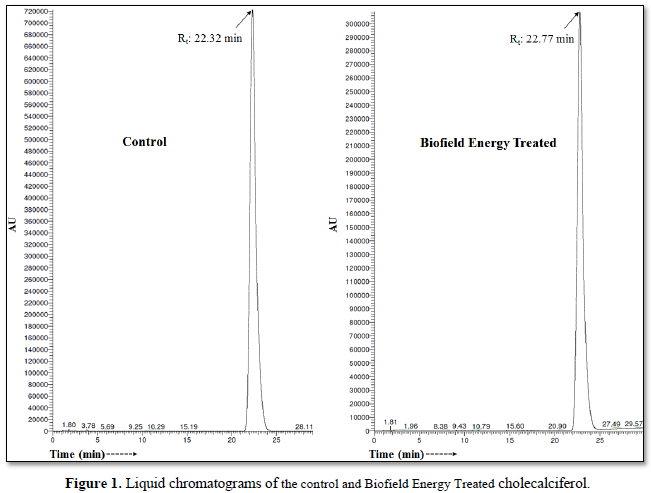
The cholecalciferol samples showed the mass of a molecular ion at m/z 385.25 with 100% relative abundance in the spectra. The theoretical calculation of isotopic peak PM+1 for the protonated cholecalciferol presented as below:
P (13C) = [(27 x 1.1%) x 100% (the actual size of the M+ peak)] / 100% = 29.7%
P (2H) = [(45 x 0.015%) x 100%] / 100%= 0.675%
P (17O) = [(1 x 0.04%) x 100%] / 100% = 0.04%
PM+1 i. e.13C, 2H, and 17O contributions from C27H45O+ to m/z 386.25 = 30.42%
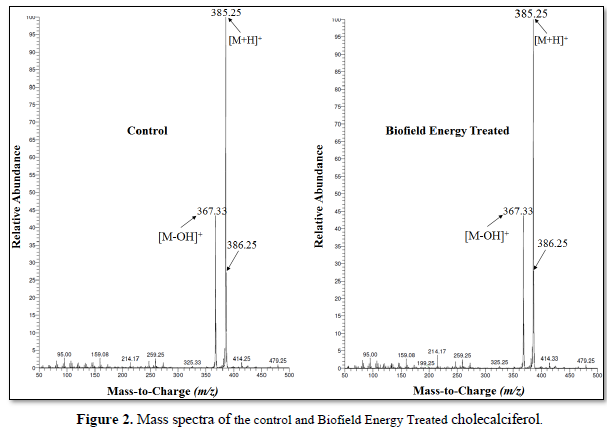
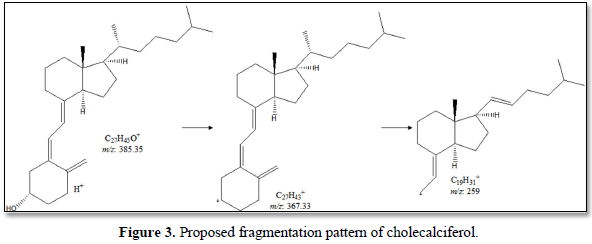


The calculated isotopic abundance of PM+1 value 30.42% was higher to the experimental value (27.76%) (Table 1). From the above calculation, it has been found that 13C has the major contribution to m/z 386.25.
The isotopic abundance ratio analysis PM and PM+1 for cholecalciferol near m/z 385.25 and 386.25, respectively, which were obtained from the observed relative peak intensities of [M+] and [(M+1) +] peaks, respectively in the ESI-MS spectra (Table 1). The isotopic abundance ratio of PM+1/PM (2H/1H or 13C/12C or 17O/16O) in treated cholecalciferol was increased by 2.93% compared to the control sample (Table 1). The result indicated that the 13C, 2H, and 17O contributions from C27H45O+ to m/z 386.25 in the treated cholecalciferol was increased compared to the control sample.
Gas Chromatography-Mass Spectrometry (GC-MS) Analysis
The cholecalciferol samples showed two major independent peaks in the chromatograms (Figures 4 and 5). The Rt of the control cholecalciferol was at 21.9 and 22.56 min, whereas 21.95 and 22.64 min is for the treated cholecalciferol, which indicated that the polarity of both the sample was very close (Figures 4 and 5). The two prominent peaks in the chromatogram might be due to the cis and trans isomers of cholecalciferol in the sample [40,41].


The molecular ion peak with respect to the Rt of 22 min exhibited the presence of cholecalciferol (C27H44O+) at m/z 385 (calcd for C27H44O+, 384.34). The low molecular mass fragmentation peak at m/z 367 [C27H43] + and 352 [C26H40] + were also observed in both the spectra (Figures 4 and 5). The mass peak intensities of the Biofield Energy Treated cholecalciferol were altered compared to the control sample.
The GC-MS spectra of both the cholecalciferol showed the mass of the molecular ion peak [M]+ at m/z 385. The theoretical calculation of PM+1 and PM+2 for cholecalciferol was presented as below:
P (13C) = [(27 x 1.1%) x 7.32% (the actual size of the M+ peak)] / 100% = 2.17%
P (2H) = [(44 x 0.015%) x 7.32%] / 100%= 0.05%
P (17O) = [(1 x 0.04%) x 7.32%] / 100% = 0.003%
PM+1 i. e.13C, 2H, and 17O contributions from C27H45O+ to m/z 386 = 2.22%
Similarly, the theoretical calculation of isotopic peak PM+2 for the protonated cholecalciferol was presented below:
P (18O) = [(1 x 0.20%) x 7.32%] / 100% = 0.015%
PM+2 of 18O contribution from C27H45O+ to m/z 387 = 0.015%
The calculated isotopic abundance of PM+1 and PM+2 values were very close to the calculated value (Table 2).
From the above calculation, it has been found that 13C and 18O have major contribution to m/z 386 and 387 of cholecalciferol.
From the above calculation, it has been found that 13C and 18O have major contribution to m/z 386 and 387 of cholecalciferol.
The GC-MS based isotopic abundance ratio analysis of the treated sample was calculated compared to the control sample. PM, PM+1, and PM+2 for cholecalciferol near m/z 385 [M+], 386 [(M+1) +], and 387 [(M+2)+], respectively of both the samples, which were obtained from the mass spectra. The isotopic abundance ratios of PM+1/PM and PM+2/PM in the treated sample was increased by 1.53% and 3.22%, respectively compared to the control sample (Table 2). Therefore, the 13C, 2H, 17O and 18O contributions from C27H44O+ to m/z 386 and 387 in the treated cholecalciferol were significantly increased compared with the control sample.
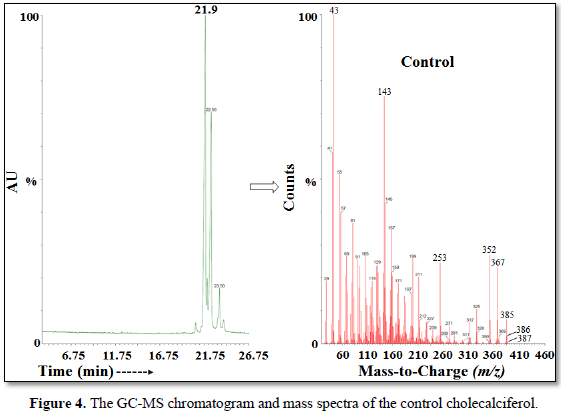
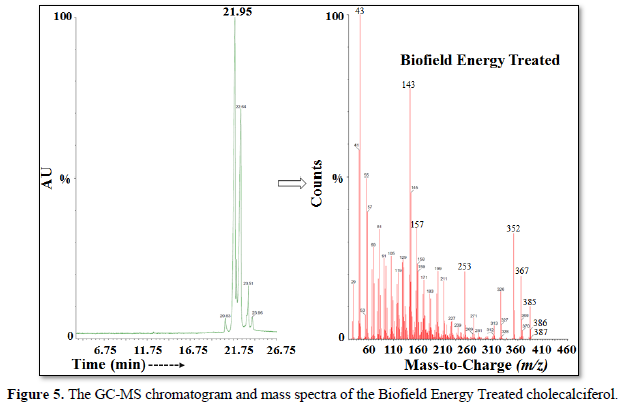




LC-MS and GC-MS study confirmed the structure of cholecalciferol. The isotopic abundance ratios of PM+1/PM (2H/1H or 13C/12C or 17O/16O) and PM+2/PM (18O/16O) in the treated cholecalciferol were increased compared to the control sample. The increased isotopic composition of the Consciousness Energy Healing Treated cholecalciferol might have interacted the neutron to proton ratio in the nucleus via the possible mediation of neutrino [15]. Neutrino is a subatomic particle abundantly found in the universe with no electrical charge and a very small mass. The neutrinos have the ability to interact with protons and neutrons in the nucleus, which might have a close relation between neutrino and the isotope formation [15, 34, 35]. The isotopic abundance ratios 2H/1H or 13C/12C or 17O/16O or 18O/16O would influence the atomic bond vibration of treated cholecalciferol [42]. The increased isotopic abundance ratio of the treated cholecalciferol may increase the intra-atomic bond strength, increase its stability, and shelf-life. The Trivedi Effect®-Consciousness Energy Healing Treated cholecalciferol would be more stable and suitable for the prevention and treatment of various diseases such as vitamin D deficiency, rickets, arthritis, osteoporosis, multiple sclerosis, cancer, diabetes mellitus, cardiovascular diseases, mental disorders, hypertension, infections, cognitive impairment in older adults, influenza, Parkinson’s and Alzheimer’s diseases, autoimmune disease, dementia, multiple sclerosis, glucose intolerance, etc.
CONCLUSIONS
The Trivedi Effect®-Consciousness Energy Healing Treatment has shown a significant impact on the isotopic abundance ratios of cholecalciferol. The LC-MS spectra of both the samples at retention time (Rt) ~22 min exhibited the mass of the molecular ion peak at m/z 385.25 (calcd for C27H45O+, 385.35). The LC-MS based isotopic abundance ratio of PM+1/PM in the Biofield Energy Treated cholecalciferol was increased by 2.93% compared with the control sample. Similarly, the GC-MS based isotopic abundance ratio of PM+1/PM and PM+2/PM in the Biofield Energy Treated cholecalciferol was increased by 1.53% and 3.22%, respectively compared with the control sample. Hence, 13C, 2H, 17O, and 18O contributions from C27H44O+ to m/z 386 and 387 in the Biofield Energy Treated cholecalciferol were significantly increased compared with the control sample. The isotopic abundance ratios of PM+1/PM (2H/1H or 13C/12C or 17O/16O) and PM+2/PM (18O/16O) in the Biofield Energy Treated cholecalciferol were significantly increased compared to the control sample. The increased isotopic composition of the Trivedi Effect®-Consciousness Energy Healing Treated cholecalciferol might have altered the neutron to proton ratio in the nucleus via the possible mediation of neutrino. The increased isotopic abundance ratio of the Biofield Energy Treated cholecalciferol may increase the intra-atomic bond strength, stability, and shelf-life. The new form of cholecalciferol would be more efficacious pharmaceutical/nutraceutical formulations for the prevention and treatment of various diseases such as vitamin D deficiency, rickets, osteoporosis, arthritis, multiple sclerosis, cancer, mental disorders, diabetes mellitus, cardiovascular diseases, hypertension, infections, influenza, cognitive impairment in older adults, Parkinson’s and Alzheimer’s diseases, dementia, autoimmune disease, glucose intolerance, multiple sclerosis, etc.
ACKNOWLEDGEMENTS
The authors are grateful to Sophisticated Instrumentation Centre for Applied Research & Testing (SICART) India, Trivedi Science, Trivedi Global, Inc., and Trivedi Master Wellness for their assistance and support during this work.
- Kulie T, Groff A, Redmer J, Hounshell J, Schrager S (2009) Vitamin D: An Evidence-Based Review. J Am Board Fam Med 22: 698-706.
- Nair R, Maseeh A (2012) Vitamin D: The "sunshine" vitamin. J Pharmacol Pharmacother 3: 118-26.
- Coulston AM, Carol B, Mario F (2013) Nutrition in the prevention and treatment of disease. Academic Press. pp: 818.
- Samuel S, Sitrin MD (2008) Vitamin D's role in cell proliferation and differentiation. Nutr Rev 66: S116-124.
- Simana E, Simian R, Portnoy S, Jaffe, A, Dekel BZ (2015) Feasibility Study -Vitamin D loading determination by FTIR-ATR. Information & Control Systems 76: 107-111.
- Ritu G, Gupta A (2014) Vitamin D Deficiency in India: Prevalence, Causalities and Interventions. Nutrients 6: 729-775.
- Lawson DE, Wilson PW, Kodicek E (1969) Metabolism of vitamin D. A new cholecalciferol metabolite, involving loss of hydrogen at C-1, in chick intestinal nuclei. Biochem J 115: 269-277.
- Ross CA, Taylor CL, Yaktine AL, Valle HBD (2010) Dietary reference intakes for calcium and Vitamin D. Washington (DC): National Academies Press (US); 2011. Accessed on: May 2, 2018. Available online at: https://pubmed.ncbi.nlm.nih.gov/21796828/
- Koshy KT, Beyer WF (1984) Vitamin D3 (Cholecalciferol) in Analytical Profiles of Drug Substances, Florey K (Ed.), Vol 13, Academic Press, Inc., Orlando, USA, pp: 656-707.
- Collins ED, Norman AW (2001) Vitamin D in Handbook of Vitamins, 3rd Rucker RB, Suttie JW, McCormick DB, Machlin LJ, Marcel Dekker, Inc., New York, pp: 51-114.
- Lehmann U, Hirche F, Stangl GI, Hinz K, Westphal S, et al. (2013) Bioavailability of vitamin D (2) and D (3) in healthy volunteers, a randomized placebo-controlled trial. J Clin Endocrinol Metab 98: 4339-4345.
- Branton A, Jana S (2017) The use of novel and unique biofield energy healing treatment for the improvement of poorly bioavailable compound, berberine in male Sprague Dawley rats. Am J Clin Exp Med 5: 138-144.
- Branton A, Jana S (2017) The influence of energy of consciousness healing treatment on low bioavailable resveratrol in male Sprague Dawley rats. Int J Clin Dev Anatomy 3: 9-15.
- Branton A, Jana S (2017) Effect of the biofield energy healing treatment on the pharmacokinetics of 25-hydroxyvitamin D3 [25(OH)D3] in rats after a single oral dose of vitamin D3. Am J Pharmacol Phytother 2: 11-18.
- Trivedi MK, Mohan TRR (2016) Biofield Energy Signals, Energy Transmission and Neutrinos. Am J Mod Phys 5: 172-176.
- Rubik B, Muehsam D, Hammerschlag R, Jain S (2015) Biofield Science and Healing: History, Terminology, and Concepts. Global Adv Health Med 4: 8-14.
- Warber SL, Cornelio D, Straughn, J, Kile G (2004) Biofield energy healing from the inside. J Altern Complement Med 10: 1107-1113.
- Movaffaghi Z, Farsi M (2009) Biofield therapies: biophysical basis and biological regulations? Complement Ther Clin Pr 15: 35-37.
- Koithan M (2009) Introducing complementary and alternative therapies. J Nurse Pract 5: 18-20.
- Barnes PM, Bloom B, Nahin RL (2008) Complementary and alternative medicine use among adults and children: United States, 2007. Natl Health Stat Report 12: 1-23.
- Branton A, Trivedi MK, Nayak G, Trivedi D, Jana S (2018) Evaluation of the effect of biofield energy treatment on physicochemical and thermal properties of hydroxypropyl β-cyclodextrin. J Pharm Pharmacol 6: 5.
- Nayak G, Trivedi MK, Branton A, Trivedi D, Jana S (2018) Evaluation of the effect of consciousness energy healing treatment on the physicochemical and thermal properties of selenium. J New Dev Chem 2: 13-23.
- Nayak G, Trivedi MK, Branton A, Trivedi D, Jana S (2018) Evaluation of the physicochemical and thermal properties of chromium trioxide (CrO3): Impact of consciousness energy healing treatment. Res Dev Mater Sci 8: 1-6.
- Nayak G, Trivedi MK, Branton A, Trivedi D, Jana S (2018) Consciousness energy healing treatment: Impact on physicochemical and thermal properties of silver sulfadiazine. J Adv Pharm Sci Technol 2: 1-13.
- Trivedi D, Trivedi MK, Branton A, Nayak G, Jana S (2019) Consciousness energy healing treatment: Impact on the physicochemical and thermal properties of ascorbic acid. Food Nutr Current Res 2: 164-173.
- Trivedi MK, Branton A, Trivedi D, Nayak G, Sethi KK, et al. (2016) Isotopic abundance ratio analysis of biofield energy treated indole using gas chromatography-mass spectrometry. Sci J Chem 4: 41-48.
- Trivedi MK, Branton A, Trivedi D, Shettigar H, Nayak G, et al. (2015) Assessment of antibiogram of multidrug-resistant isolates of Enterobacter aerogenes after biofield energy treatment. J Pharma Care Health Sys 2: 145.
- Trivedi MK, Branton A, Trivedi D, Shettigar H, Nayak G, Gangwar M, et al. (2015) Antibiogram typing of biofield treated multidrug resistant strains of Staphylococcus Am J Life Sci 3: 369-374.
- Trivedi MK, Patil S, Shettigar H, Mondal SC, Jana S (2015) The potential impact of biofield treatment on human brain tumor cells: A time-lapse video microscopy. J Integr Oncol 4: 141.
- Trivedi MK, Patil S, Shettigar H, Gangwar M, Jana S (2015) In vitro evaluation of biofield treatment on cancer biomarkers involved in endometrial and prostate cancer cell lines. J Cancer Sci Ther 7: 253-257.
- Trivedi MK, Branton A, Trivedi D, Nayak G, Mondal SC, et al. (2015) Evaluation of plant growth regulator, immunity and DNA fingerprinting of biofield energy treated mustard seeds (Brassica juncea). Agric Forest Fisheries 4: 269-274.
- Trivedi MK, Branton A, Trivedi D, Nayak G, Bairwa K, Jana S (2015) Physical, thermal, and spectroscopic characterization of biofield energy treated murashige and skoog plant cell culture media. Cell Biol 3: 50-57.
- Schellekens RC, Stellaard F, Woerdenbag HJ, Frijlink HW, Kosterink JG (2011) Applications of stable isotopes in clinical pharmacology. Br J Clin Pharmacol 72: 879-897.
- Muccio Z, Jackson GP (2009) Isotope ratio mass spectrometry. Analyst 134: 213-222.
- Weisel CP, Park S, Pyo H, Mohan K, Witz G (2003) Use of stable isotopically labeled benzene to evaluate environmental exposures. J Expo Anal Environ Epidemiol 13: 393-402.
- Rosman KJR, Taylor PDP (1998) Isotopic compositions of the elements 1997 (Technical Report). Pure Appl Chem 70: 217-235.
- Smith RM (2004) Understanding Mass Spectra: A Basic Approach, 2nd John Wiley & Sons, Inc.
- Jürgen H (2004) Gross Mass Spectrometry: A Textbook. 2nd Springer: Berlin.
- Predicted MS/MS Spectrum - 10V, Positive (Annotated) (DB00169). Available online at: https://www.drugbank.ca/spectra/ms_ms/61218
- Holick MF, Garabedian M, DeLuca HF (1972) 5,6-Trans isomers of cholecalciferol and 25-hydroxycholecalciferol. Substitutes for 1,25-dihydroxycholecalciferol in anephric animal. Biochemistry 11: 2715-2719.
- Okamura WH, Midland MM, Hammond MW, Abd Rahman N, Dormanen MC, et al. (1995) Chemistry and conformation of vitamin D molecules. J Steroid Biochem Mol Biol 53: 603-613.
- Santesteban LG, Miranda C, Barbarin I, Royo JB (2014) Application of the measurement of the natural abundance of stable isotopes in viticulture: A review. Aust J Grape Wine Res 21: 157-167.








